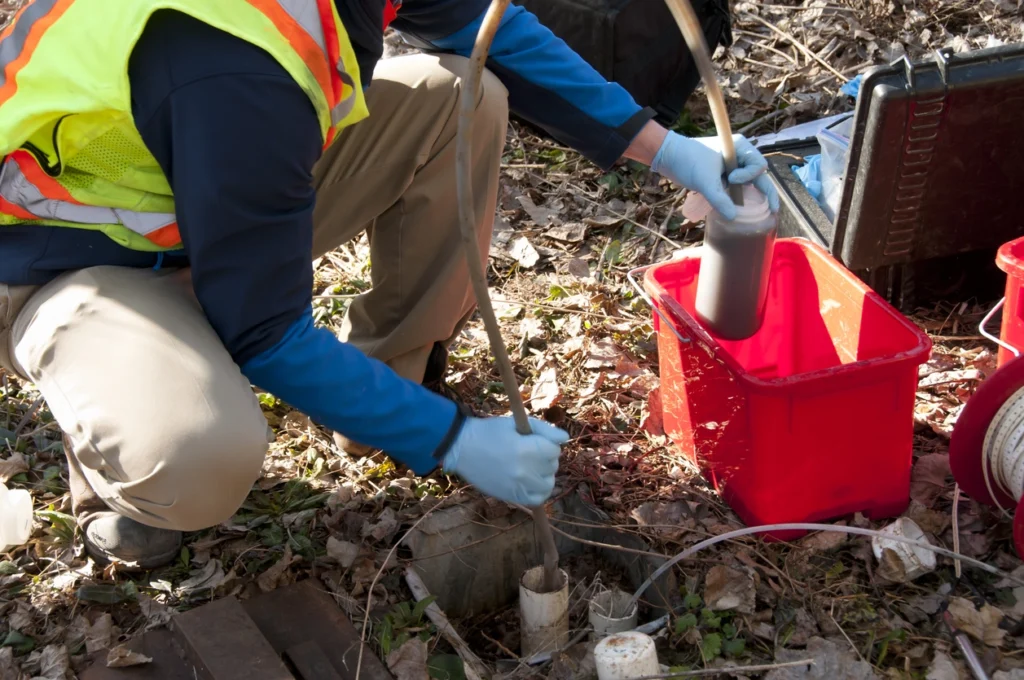An Environmental Condition Report (ECR) is a thorough assessment of a property’s current environmental state, designed to identify any potential contamination or hazards. Conducted by qualified environmental professionals, an ECR typically involves reviewing historical records, conducting a site inspection, and potentially, testing soil, water, and building materials. It plays a crucial role in real estate transactions, informing all parties involved about the risks and responsibilities associated with the property.

Why Environmental Condition Reports Matter
Investing in an ECR might seem like an additional expense, but the potential consequences of overlooking environmental issues can be far more costly. Here’s why ECRs are essential:
Uncovering Hidden Risks
ECRs can reveal contamination from past industrial activity, illegal dumping, or improper waste disposal. This knowledge prevents unpleasant surprises later on.
Avoiding Liability
Buyers armed with an ECR can better protect themselves from future liability for environmental cleanup, which can be financially devastating.
Ensuring Compliance
Many jurisdictions have environmental regulations that property owners must follow. An ECR helps identify potential compliance issues early on, allowing for timely remediation.
Facilitating Informed Decision-Making
An ECR provides a clear and objective picture of a property’s environmental health. This empowers buyers, sellers, and lenders to make informed decisions based on a solid understanding of potential risks and associated costs.

What’s Typically Included in an ECR
An Environmental Condition Report isn’t a simple checklist – it’s a comprehensive investigation tailored to the specific property. However, most ECRs will include the following key components:
Site History
Environmental professionals delve into the property’s past, examining historical records, maps, and aerial photographs. This helps identify previous uses that might raise red flags, such as gas stations, dry cleaners, industrial facilities, or even former landfills.
Visual Inspection
A trained assessor will carefully examine the site in person, looking for any visual clues that suggest potential contamination. These might include stained soil, distressed vegetation, unusual odors, improper storage of chemicals or waste, or signs of leaks and spills.
Environmental Sampling
If the initial investigation raises concerns, environmental sampling becomes necessary. This involves collecting soil, water, or building material samples for laboratory analysis. The types of tests performed will depend on the suspected contaminants based on the site’s history.
Regulatory Review
The assessor will research the property’s environmental compliance history. They’ll check for any relevant permits, past violations, or ongoing environmental investigations that might create liability for the new owner.
The scope of an ECR can vary depending on the property’s size, history, and the level of risk tolerance of the buyer or lender.
Understanding the Report
Environmental Condition Reports can contain a fair amount of technical information. Let’s break down how to navigate them and make sense of the findings:
- Clear Explanations: A good ECR won’t just list contaminants. It should provide clear explanations of the substances found, their potential sources, and how they compare to regulatory safety thresholds. The report should also define any technical terms used for clarity.
- Levels of Risk: The ECR should categorize any identified contamination in terms of its severity. Some findings may be minor, requiring simple solutions, while others could signal serious hazards with significant cost implications.
- Recommendations and Next Steps: While it might seem daunting, a report that identifies issues should also offer a roadmap for the next steps. This could include:
- Remediation Plans: If contamination is present, the report should outline potential clean-up strategies and estimated costs.
- Further Investigation: Sometimes, the ECR suggests additional in-depth testing to pinpoint the extent of contamination or identify its precise origins.
- Negotiation Guidance: The report’s findings can be used as a bargaining tool between the buyer and seller, informing discussions about price adjustments or the responsibility for future remediation.
Don’t be afraid to ask questions! The environmental professional who conducted the assessment should be prepared to explain the report in plain language and guide you through any recommended actions.

When an ECR is Needed
While not always mandatory, Environmental Condition Reports are highly recommended in the following situations:
Real Estate Transactions
Commercial and industrial property buyers often insist on an ECR before closing a deal. This protects them from the surprise costs associated with inherited contamination. Lenders may also require an ECR as a condition for financing, safeguarding their investment.
Due Diligence
Even without lender requirements, sellers may proactively commission an ECR. This demonstrates transparency and can facilitate a smoother sale by addressing potential concerns early in the process.
Regulations and Liability
- Specific Laws: Some jurisdictions have laws mandating environmental assessments for certain types of properties or transactions. For example, the EPA’s “All Appropriate Inquiries” (AAI) rule sets standards for environmental due diligence.
- Liability Protection: Even in the absence of strict legislation, an ECR can be a crucial tool for limiting liability. By demonstrating that appropriate investigations were conducted, a property owner can potentially avoid costly penalties and cleanup obligations down the line.
Environmental regulations can vary between regions and change over time. It’s always wise to consult with legal counsel or qualified environmental professionals to understand the specific requirements that apply in your area.
Choosing a Qualified Environmental Assessor
The quality of your Environmental Condition Report depends heavily on the expertise of the assessor you choose. Here’s what to look for:
Credentials
Seek professionals with relevant certifications and designations. For example, a Registered Environmental Property Assessor (REPA) or a Certified Environmental Manager (CEM) demonstrates specialized knowledge in this area. Check their affiliations with professional organizations, which often signals commitment to ongoing education and industry standards.
Experience
Look for assessors who have extensive experience conducting environmental assessments on similar properties. Experience within your specific industry or region can be a significant advantage, as they’ll understand the unique risks and regulations involved.
Scope and Cost
- Thorough Scope: Before accepting a quote, ensure the proposed scope of work aligns with your needs and any regulatory requirements. Ask about all elements included: historical review, site inspection, sampling (if applicable), and the level of detail in the report.
- Cost Considerations: The cost of an ECR can vary depending on the property’s size, complexity, and location. It’s wise to get quotes from several qualified assessors to compare prices and scope. However, don’t let price be the sole deciding factor – experience and relevant expertise are crucial.
Additional Tips:
- Check References: Ask potential assessors to provide references from past clients to learn about their work quality and communication style.
- Clear Communication: Choose an assessor who is willing to explain complex information clearly and answer all of your questions thoroughly.
Environmental Condition Report: What You Need to Know
In the complex world of property transactions and environmental regulations, an Environmental Condition Report (ECR) offers a powerful tool for all involved parties. By investing in a thorough ECR, you invest in peace of mind, informed decision-making, and the long-term health of the property in question.
While the upfront costs might give some pause, remember that overlooking potential environmental issues can lead to far greater financial and legal consequences in the future. By choosing a qualified assessor and understanding the report’s findings, you can proactively address any risks and make the best possible decisions for your investment.
Frequently Asked Questions About an Environmental Condition Report
Who typically pays for an ECR?
While there’s no single rule, the buyer usually covers the cost of an ECR in a real estate transaction. This allows them to independently assess the property and protect their interests. However, in competitive markets or when serious concerns are suspected, the seller might sometimes cover part or all of the ECR costs to show commitment to transparency. Ultimately, the responsibility for payment can be negotiated as part of the overall deal.
How long does it take to get an ECR?
The timeline varies depending on the property’s complexity and scope of work. Some factors that influence duration include:
- Records Review: The availability and accessibility of historical documents can impact this stage.
- Site Inspection: Larger sites take longer to thoroughly examine.
- Sampling & Lab Analysis: If needed, labs have their own turnaround times, and results could require interpretation.
Generally, you can expect a few weeks for the complete process. A qualified assessor should be able to provide a more specific estimate based on your property.
What’s the difference between a Phase I and Phase II Environmental Site Assessment?
Both are tools for due diligence, but they differ in their depth:
- Phase I ECR: This is the starting point. It focuses on historical records, visual inspection, and identifying potential contamination risks. If a Phase I raises concerns, it usually recommends a Phase II.
- Phase II: Involves actual sampling and testing of soil, water, etc. to confirm or rule out the presence of contamination suspected in the Phase I. It helps determine the extent and severity of any issues.
Can an ECR affect my property value?
Yes, the findings of an ECR can significantly impact the property’s perceived value and its marketability.
- Clean Bill of Health: This confirms the absence of major concerns, increasing the property’s appeal and strengthening negotiating power.
- Minor Issues: With clear remediation plans, the impact might be minimal, especially if costs can be factored into the price.
- Serious Contamination: This could lead to significant price reductions, the need for the seller to address the issue before sale, or even derail the transaction entirely.
Are there limits to what an environmental condition report can uncover?
While ECRs are comprehensive, it’s important to understand they’re not foolproof. Some limitations include:
- Historical Gaps: Records might be incomplete, especially for very old properties, making it harder to identify past uses.
- Visual Inspection Limits: Not all contamination leaves visible clues. Further sampling might be needed.
- Scope Restrictions: Some buyers might opt for a limited ECR to save costs, but this increases the risk of missing potential issues.
An ECR is a powerful risk assessment tool, but it’s not a guarantee. Working with an experienced assessor is crucial to maximize its effectiveness.